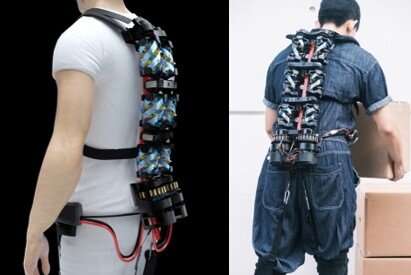
In an innovative leap forward for workplace safety, a research team at Seoul National University has developed the Bilateral Back Extensor Exosuit (BBEX), a robotic back-support device designed to prevent spinal injuries and assist workers in heavy lifting tasks.
The BBEX, introduced in a study published in Science Robotics, promises to address the shortcomings of existing back-support devices by providing multidimensional assistance and comprehensive safety validation. The paper is titled “Bilateral Back Extensor Exosuit for Multidimensional Assistance and Prevention of Spinal Injuries.”
Lower back injuries from heavy or repetitive lifting are a major concern in various industries, leading to significant physical and economic impacts. Traditional back-support devices have attempted to mitigate these risks, but they often fall short, especially in scenarios requiring asymmetric lifting, which is common in many workplace settings.
The BBEX stands out by closely mimicking the biomechanics of the human spine and back extensor muscles, providing effective support in multiple directions.
The design of the BBEX is inspired by the anatomical structure of the human spine and the erector spinae muscles. It features a multi-degree-of-freedom (DoF) architecture with serially connected linear actuators, allowing it to move naturally with the spine and provide targeted assistance.
This intricate design ensures that the device can offer comprehensive support during both symmetric and asymmetric lifting tasks, effectively reducing muscle fatigue and mechanical loading on spinal joints.

The research team conducted extensive experiments with eleven healthy male participants to validate the efficacy and safety of the BBEX. Participants performed lifting tasks while wearing the device, and the results were promising. The BBEX successfully provided multidimensional force assistance, reduced muscle fatigue in the back extensor muscles, and decreased compression forces on spinal joints. These findings suggest that the BBEX could significantly lower the risk of lower back injuries in demanding work environments.
By seamlessly integrating functionality inspired by human biomechanics with a focus on safety, the BBEX offers a groundbreaking solution to a persistent workplace challenge. The device not only enhances the ability of workers to perform heavy lifting tasks but also prioritizes their long-term health and safety.
As industries continue to seek ways to improve worker safety and productivity, the BBEX represents a significant step forward in the development of effective and reliable back-support technologies.
More information:
Jae In Kim et al, Bilateral Back Extensor Exosuit for multidimensional assistance and prevention of spinal injuries, Science Robotics (2024). DOI: 10.1126/scirobotics.adk6717
Seoul National University College of Engineering
Improving workplace safety: The Bilateral Back Extensor Exosuit (2024, August 22)
retrieved 22 August 2024
from https://techxplore.com/news/2024-08-workplace-safety-bilateral-extensor-exosuit.html
part may be reproduced without the written permission. The content is provided for information purposes only.

In an innovative leap forward for workplace safety, a research team at Seoul National University has developed the Bilateral Back Extensor Exosuit (BBEX), a robotic back-support device designed to prevent spinal injuries and assist workers in heavy lifting tasks.
The BBEX, introduced in a study published in Science Robotics, promises to address the shortcomings of existing back-support devices by providing multidimensional assistance and comprehensive safety validation. The paper is titled “Bilateral Back Extensor Exosuit for Multidimensional Assistance and Prevention of Spinal Injuries.”
Lower back injuries from heavy or repetitive lifting are a major concern in various industries, leading to significant physical and economic impacts. Traditional back-support devices have attempted to mitigate these risks, but they often fall short, especially in scenarios requiring asymmetric lifting, which is common in many workplace settings.
The BBEX stands out by closely mimicking the biomechanics of the human spine and back extensor muscles, providing effective support in multiple directions.
The design of the BBEX is inspired by the anatomical structure of the human spine and the erector spinae muscles. It features a multi-degree-of-freedom (DoF) architecture with serially connected linear actuators, allowing it to move naturally with the spine and provide targeted assistance.
This intricate design ensures that the device can offer comprehensive support during both symmetric and asymmetric lifting tasks, effectively reducing muscle fatigue and mechanical loading on spinal joints.

The research team conducted extensive experiments with eleven healthy male participants to validate the efficacy and safety of the BBEX. Participants performed lifting tasks while wearing the device, and the results were promising. The BBEX successfully provided multidimensional force assistance, reduced muscle fatigue in the back extensor muscles, and decreased compression forces on spinal joints. These findings suggest that the BBEX could significantly lower the risk of lower back injuries in demanding work environments.
By seamlessly integrating functionality inspired by human biomechanics with a focus on safety, the BBEX offers a groundbreaking solution to a persistent workplace challenge. The device not only enhances the ability of workers to perform heavy lifting tasks but also prioritizes their long-term health and safety.
As industries continue to seek ways to improve worker safety and productivity, the BBEX represents a significant step forward in the development of effective and reliable back-support technologies.
More information:
Jae In Kim et al, Bilateral Back Extensor Exosuit for multidimensional assistance and prevention of spinal injuries, Science Robotics (2024). DOI: 10.1126/scirobotics.adk6717
Seoul National University College of Engineering
Improving workplace safety: The Bilateral Back Extensor Exosuit (2024, August 22)
retrieved 22 August 2024
from https://techxplore.com/news/2024-08-workplace-safety-bilateral-extensor-exosuit.html
part may be reproduced without the written permission. The content is provided for information purposes only.









